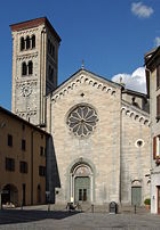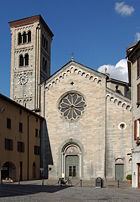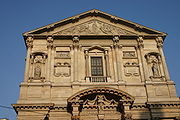
Fidelis of Como
Encyclopedia
Saint Fidelis of Como (died ca. 304 AD) was an Italian
soldier-saint.
, two soldier-saints. Variations on their legend are applied to Fidelis. The first says that he, with Carpophorus and Exanthus, were Roman soldiers, members of the legend
ary Theban Legion
, who deserted during the persecution of Christians by Maximian
. They were caught and executed at Como. The second says that Fidelis was an army officer who was guarding Christian prisoners at Milan, including Saint Alexander of Bergamo. He managed to procure the freedom of five of these prisoners. With Carpophorus and Exanthus, he and these five attempted to make their way to the Alps, but were executed at Como. The martyrdom of Fidelis is considered to have occurred on the north side of Lake Como
, near Samolaco
.
 The cult of Fidelis at Como is ancient. Magnus Felix Ennodius
The cult of Fidelis at Como is ancient. Magnus Felix Ennodius
describes, in the early sixth century, a tomb at Como containing the relics of the martyr. Reports of miracles at the tomb fomented the popularity of his cult. Sometime before 1000, the church of Sanfedelino, which was dedicated to him, was built on the site of a much earlier simple chapel
, which dates from around the fourth century.
Milan, Como, and Arona claim the relics of Fidelis.
Relics are said to have been transferred to Arona during a time of war between Milan and Como
. In Arona, the presence of the relics of Fidelis and Carpophrous is attested in documents dating back to 1259 and 1321.
Como's claim is based on an account of 964 that describes the translation
of Fidelis' relics from the spot where he was killed to Como in that year.
 In 1576, Charles Borromeo
In 1576, Charles Borromeo
transferred to Milan
relics of Carpophorus and Fidelis. Though until then their veneration in Arona was minimal, Borromeo's proposed transfer angered the people of the city. As a compromise, Borromeo brought back to Arona the two left forearms of the saints. This occurred on March 13. The city council, which had been pressured by the populace to bring back the relics, decreed that an annual festival occur on that day, which in succeeding centuries has increased in importance. The purpose of the festival was extended to include the celebration for the martyrs Felinus and Gratian
, thereby uniton a conceptual claim, particular architectural use for two-dimensional by-products ing their cult to that of Carpophorus and Fidelis.
At Milan, Borromeo commissioned the church of San Fedele
to Pellegrino Tibaldi
(1559).
Italy
Italy , officially the Italian Republic languages]] under the European Charter for Regional or Minority Languages. In each of these, Italy's official name is as follows:;;;;;;;;), is a unitary parliamentary republic in South-Central Europe. To the north it borders France, Switzerland, Austria and...
soldier-saint.
Legends
Fidelis' cult is associated with Carpophorus and ExanthusCarpophorus, Exanthus, Cassius, Severinus, Secundus, and Licinius
Carpophorus, Exanthus, Cassius, Severinus, Secundus and Licinius were Christian soldiers who, according to local tradition, were martyred at Como during the reign of Maximian.-Legends:...
, two soldier-saints. Variations on their legend are applied to Fidelis. The first says that he, with Carpophorus and Exanthus, were Roman soldiers, members of the legend
Legend
A legend is a narrative of human actions that are perceived both by teller and listeners to take place within human history and to possess certain qualities that give the tale verisimilitude...
ary Theban Legion
Theban Legion
The Theban Legion figures in Christian hagiography as an entire Roman legion — of "six thousand six hundred and sixty-six men" — who had converted en masse to Christianity and were martyred together, in 286, according to the hagiographies of Saint Maurice, the chief among the Legion's...
, who deserted during the persecution of Christians by Maximian
Maximian
Maximian was Roman Emperor from 286 to 305. He was Caesar from 285 to 286, then Augustus from 286 to 305. He shared the latter title with his co-emperor and superior, Diocletian, whose political brain complemented Maximian's military brawn. Maximian established his residence at Trier but spent...
. They were caught and executed at Como. The second says that Fidelis was an army officer who was guarding Christian prisoners at Milan, including Saint Alexander of Bergamo. He managed to procure the freedom of five of these prisoners. With Carpophorus and Exanthus, he and these five attempted to make their way to the Alps, but were executed at Como. The martyrdom of Fidelis is considered to have occurred on the north side of Lake Como
Lake Como
Lake Como is a lake of glacial origin in Lombardy, Italy. It has an area of 146 km², making it the third largest lake in Italy, after Lake Garda and Lake Maggiore...
, near Samolaco
Samolaco
Samolaco is a comune in the Province of Sondrio in the Italian region Lombardy, located about 90 km north of the regional capital Milan and about 40 km northwest of Sondrio...
.
Veneration

Magnus Felix Ennodius
Magnus Felix Ennodius was Bishop of Pavia in 514, and a Latin rhetorician and poet.He was one of four fifth to sixth-century Gallo-Roman aristocrats whose letters survive in quantity: the others are Sidonius Apollinaris, prefect of Rome in 468 and bishop of Clermont , Ruricius bishop of Limoges ...
describes, in the early sixth century, a tomb at Como containing the relics of the martyr. Reports of miracles at the tomb fomented the popularity of his cult. Sometime before 1000, the church of Sanfedelino, which was dedicated to him, was built on the site of a much earlier simple chapel
Chapel
A chapel is a building used by Christians as a place of fellowship and worship. It may be part of a larger structure or complex, such as a church, college, hospital, palace, prison or funeral home, located on board a military or commercial ship, or it may be an entirely free-standing building,...
, which dates from around the fourth century.
Milan, Como, and Arona claim the relics of Fidelis.
Relics are said to have been transferred to Arona during a time of war between Milan and Como
Como
Como is a city and comune in Lombardy, Italy.It is the administrative capital of the Province of Como....
. In Arona, the presence of the relics of Fidelis and Carpophrous is attested in documents dating back to 1259 and 1321.
Como's claim is based on an account of 964 that describes the translation
Translation (relics)
In Christianity, the translation of relics is the removal of holy objects from one locality to another ; usually only the movement of the remains of the saint's body would be treated so formally, with secondary relics such as items of clothing treated with less ceremony...
of Fidelis' relics from the spot where he was killed to Como in that year.

Charles Borromeo
Charles Borromeo was the cardinal archbishop of the Catholic Archdiocese of Milan from 1564 to 1584. He was a leading figure during the Counter-Reformation and was responsible for significant reforms in the Catholic Church, including the founding of seminaries for the education of priests...
transferred to Milan
Milan
Milan is the second-largest city in Italy and the capital city of the region of Lombardy and of the province of Milan. The city proper has a population of about 1.3 million, while its urban area, roughly coinciding with its administrative province and the bordering Province of Monza and Brianza ,...
relics of Carpophorus and Fidelis. Though until then their veneration in Arona was minimal, Borromeo's proposed transfer angered the people of the city. As a compromise, Borromeo brought back to Arona the two left forearms of the saints. This occurred on March 13. The city council, which had been pressured by the populace to bring back the relics, decreed that an annual festival occur on that day, which in succeeding centuries has increased in importance. The purpose of the festival was extended to include the celebration for the martyrs Felinus and Gratian
Felinus and Gratian
Saints Felinus and Gratian are venerated as martyrs by the Catholic and Eastern Orthodox churches. They are patron saints of Arona, near Milan, where their relics were enshrined....
, thereby uniton a conceptual claim, particular architectural use for two-dimensional by-products ing their cult to that of Carpophorus and Fidelis.
At Milan, Borromeo commissioned the church of San Fedele
San Fedele (Milan)
San Fedele is a Jesuit church in Milan, northern Italy. It is entitled to St. Fidelis of Como, patron of the Catholic diocese of Como.Located in the centre of the city, near the Palazzo Marino, the Teatro alla Scala and the Galleria Vittorio Emanuele II, the church was commissioned by Charles...
to Pellegrino Tibaldi
Pellegrino Tibaldi
Pellegrino Tibaldi , also known as Pellegrino di Tibaldo de Pellegrini, was an Italian mannerist architect, sculptor, and mural painter.-Biography:...
(1559).

